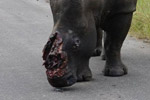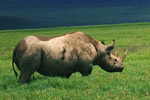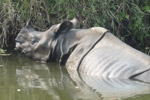The world’s stronghold for Indian rhinos—the state of Assam—has seen its population leap by 27 percent since 2006, despite a worsening epidemic of poaching that has also seen 156 rhinos killed during the same period. According to a new white paper, the population of Indian rhinos in Assam hit 2,544 this year up from a nadir of around 200 animals in the early 1900s.
Indian rhinos (Rhinoceros unicornis), like their African relatives, are facing a recent upsurge in poaching for their horn, which is ground up and consumed as a curative in East Asia. Even as there is no evidence that rhino horn has any medicinal benefits, some people in countries like Vietnam and China view consuming illegal rhino horn as a status symbol.
This year, 18 rhinos have been killed in Assam by poachers, but the government has defended its actions in combatting rhino poaching.
“We have been taking steps to stop the poaching. When our government came to power in Assam there was lack of manpower in Kaziranga [National Park]. We have increased the manpower strength to 1,200 inside the park,” Assam Forest Minister Rockybul Hussain. “We have also amended the Wildlife Protection Act so that the jail term of the poachers can be enhanced. We have also empowered the forest personnel to use arms to fight the poachers.”
Indian rhinos, also known as greater one-horned rhinos, are the world’s largest rhino species and the fifth biggest land animal. Although found in Nepal as well, the vast majority are in India and specifically in Assam’s Kaziranga National Park, which is home to over 60 percent of the population.
The government of India has pledged to see the rhino population rise to 3,000 by 2020, a goal they are currently on track to hit. Indian rhinos were moved from being categorized as Endangered to Vulnerable in 2008 due to the rising population.

Indian rhino with horn removed to prevent poaching. Photo by: Rhett A. Butler.
Related articles
Howard G. Buffett puts $24M toward saving rhinos
(03/21/2014) Howard G. Buffett, the son of Berkshire Hathaway chairman Warren Buffett, has pledged $23.7 million to South African National Parks to help fight rhino poaching in Kruger National Park, reports Reuters.
Rhino with bullet in its brain and hacked off horn wanders for days before being put down

(03/05/2014) Last week, visitors in Kruger National Park came on a horrifying sight of the poaching trade: a rhino, still alive, with its horn and part of its face chopped off. The gruesome photo of the young rhino went viral and sent South African authorities scrambling. Five days after the sighting, South African National Parks (SANParks) has announced they found the rhino and put it out of its misery.
Javan rhino population jumps by over 10 percent
(03/04/2014) The Javan rhino population has increased by over ten percent from 2012 to last year, according to new figures released by Ujung Kulon National Park. Using camera traps, rangers have counted a total of 58 Javan rhinos, up from 51 in 2012. Although the species once roamed much of Southeast Asia, today it is only found in Ujung Kulon National Park in western Javan and is known as one of the most imperiled mammals on the planet.
South Africa loses nearly 150 rhinos to poachers so far this year
(02/28/2014) Since the first of the year, South Africa has lost 146 rhinos to poachers or approximately 2.5 rhinos every day. This is a slight dip from last year’s poaching rate, which hit 1,004 for the whole year or 2.75 a day. South Africa is home to more rhinos than any other country on the planet, but the populations have been hit hard by poachers in recent years seeking rhino horn.

(02/20/2014) ‘After a long conversation with the FBI I have decided to temporarily suspend my activity on this page. I want to thank all of you who have commented [on] this important issue of Black Rhino Conservation.’ – Corey Knowlton, Feb 3, 2014. This was the last post on Corey Knowlton’s Facebook page. Knowlton is the hunter who won the Dallas Safari Club auction on January 11th to kill a Critically Endangered black rhino. All the money—$350,000—will go to a fund to protect rhinos. The plan is that sometime soon—once the paperwork clears the U.S. Fish and Wildlife Service—Knowlton will go to Namibia on a “trophy hunt” (accompanied by a park service official), shoot the designated rhino, and bring the old bull’s hide back home to Texas.
Proposed rail and road projects could devastate Nepal’s tigers and rhinos

(02/06/2014) Chitwan National Park is a conservation success story. Since its establishment in 1973 the park’s populations of both Bengal tigers (Panthera tigris tigris) and one-horned rhinos (Rhinoceros unicornis) have quintupled, a success achieved during a time when both species have been under siege globally by poachers. A UNESCO World Heritage site, the park is also a vital economic resource for locals: last year the park admitted over 150,000 tourists who brought in nearly $2 million in entry fees alone. But all this is imperiled by government plans for a new railway that would cut the park in half and a slew of new roads, according to a group of international conservationists known as the Alliance of Leading Environmental Researchers and Thinkers (ALERT).
Over 1,000 rhinos killed by poachers in South Africa last year
(01/17/2014) In another sign that Africa’s poaching crisis has gotten completely out of control, South Africa lost 1,004 rhinos to poachers last year. According to the numbers released today by the South African Department of Environmental Affairs, 2013 was the worst year yet for rhino poaching in the country with nearly 3 rhinos killed every day.













